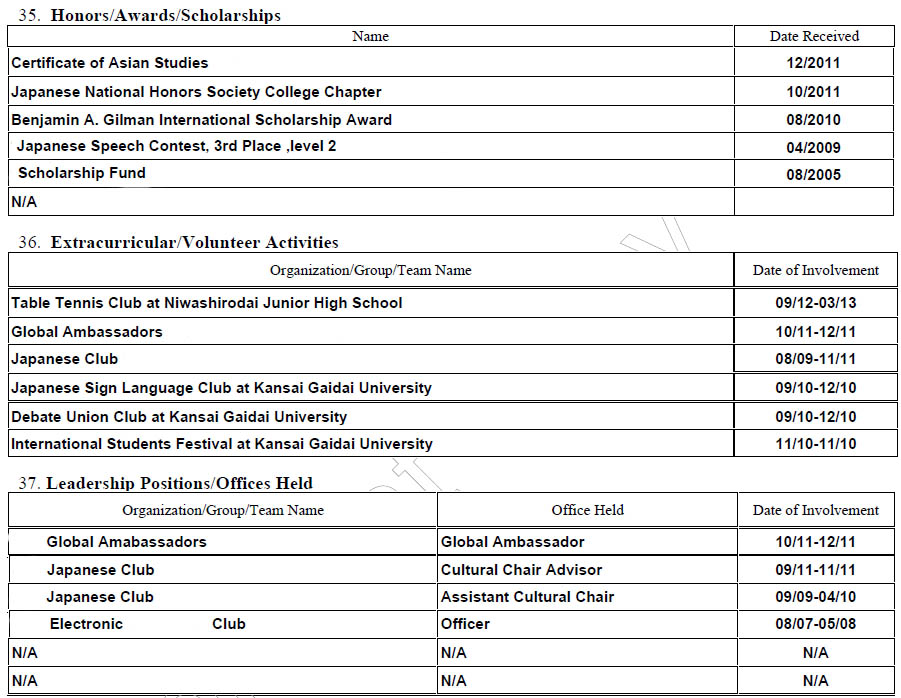
What is the Application Point System?
This is all speculation, but I assume it’s like any other hiring system where your ranking is compared with other applicants.
Honestly, it’s just a grading system to determine whether or not an applicant proceeds through every round (initial application, interview, and job offer).
JET Program coordinators and interview committees will score applications to help decide which candidates to invite for in-person interviews.
The more points you get on the main application and Statement of Purpose, the better your chances of getting an interview.
Likewise, the better your interview score is, the more likely you are to be chosen as a “short-list” JET participant.
Fill in your Application Well!
1. Fill out everything correctly – proofread all your information. Double or triple check it!
Make sure your name, address, school history, work history, etc. are all perfect, correct, and match other parts of the application where they should be the same. (I.e. if your name shouldn’t be spelled differently and you shouldn’t have to different addresses unless you are moving)
2. Fill in as much as possible – a fuller application could mean more points in more “categories.”
If you taught a class once, list it. If you participated in something related to Japan, list it. If you’ve traveled to Japan for a vacation, list it. Many things can help your application look appealing. The more experiences you have, the better. Remember, the JET application is not necessarily the same as a typical resume.
Completing sections on your Honors/Awards/Scholarships, Volunteer Activities, and Leadership Roles is crucial to getting a good score.
Example:

3. Show some Japanese skills – If you can learn some Japanese before applying, it’ll be a plus! Even introductory Japanese is better than marking “none” on the application, and it’s something you can study in a few weeks by yourself with YouTube, smartphone applications, anything. I would recommend marking “introductory” because no one is going to call you up to see if this is true or not. And you have plenty of time to learn basic Japanese before the interview!
Warning, make sure you do learn some introductory Japanese before your interview, or else you are lying, and that will show. If you are not comfortable, then mark “none.” It won’t count against you, and you can always show some Japanese skills later during the interview.

4. Awards, extracurricular activities, and positions – These are great areas to score points for your application. The more, the better! They give you lots of space to show off your extra work. Extracurricular activities can be especially useful since they showcase your willingness to participate in lots of events and activities in Japan for work, school, and the community.
5. Employment History – Be sure to fill out your employment history in detail, if you have any. If you are a graduating student, then you might only have part-time jobs to list. Still, it is good to show that you have work experience, even if it’s unrelated. Your employment history is a good signal to show that you are ready to take on the responsibilities of a full-time job.
Be sure to detail your job responsibilities and make them relatable to the program!
6. Keep your information in chronological order –
Everything should be listed chronologically. Be sure to follow this formatting on your application.
7. Your JET Program Statement of Purpose –
You will have a difficult time scoring an interview with a poorly written SoP. A well-written statement of purpose is the bread and butter of your application. Failing to write a good essay is a “no no.”
Don’t expect an interview if you haven’t worked hard on this as it means everything to your application.
It is difficult to stress how important this aspect is of your application and landing an interview, so make it your top priority when applying!
Prepare Well for Your Interview

Interview section. Here, I lay out how to do the interview and what to expect.
The interview is the most nerve-racking part of the whole process.
This part is definitely graded on your flexibility and outgoingness.
I believe the JET Programme panel is always looking at how you handle tough situations as a teacher and life in general.
The interview itself is very short, 15-20 minutes give or take and currently held on Zoom.
My best advice is not to judge your mistakes after the interview. There will always be something you could have done better.
After your interview, it’s best to ignore your entire application and everything you did because finding out answers will take months. Again, just put yourself back in the same mindset as when you did the paper application and forget it ever existed, till you get a pass or fail email from the consulate.
What if I failed?
Not everything goes as planned, there is always alternatives like ALTIA Central for teaching in Japan. There are also many other alternatives other than being an ALT.
It is not the end of the world as you will have the chance to apply again.
When reapplying, it is best to reevaluate your previous application, SoP, and interview mistakes, so you can avoid those mistakes on your future application and level up your missing skill sets.